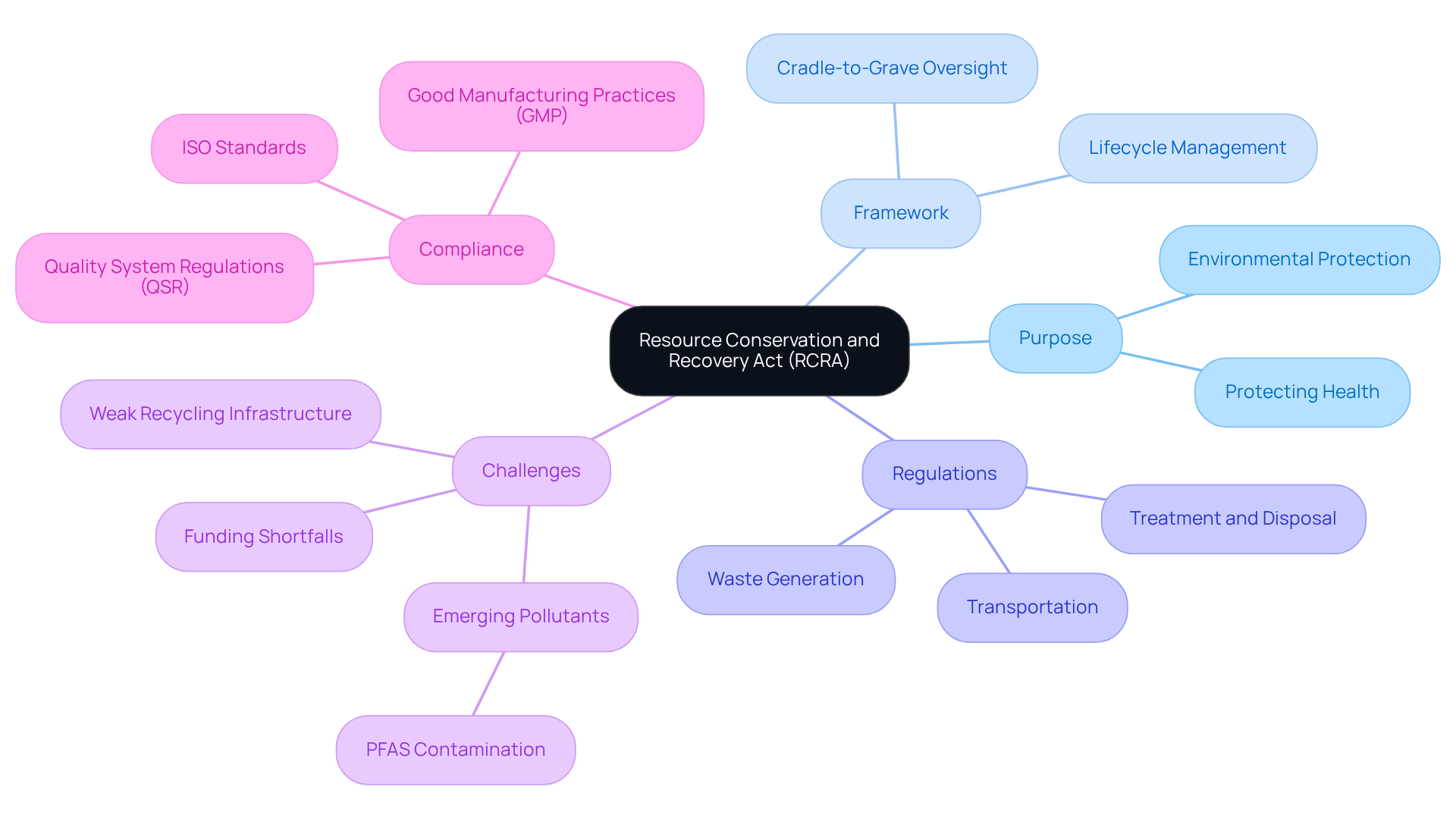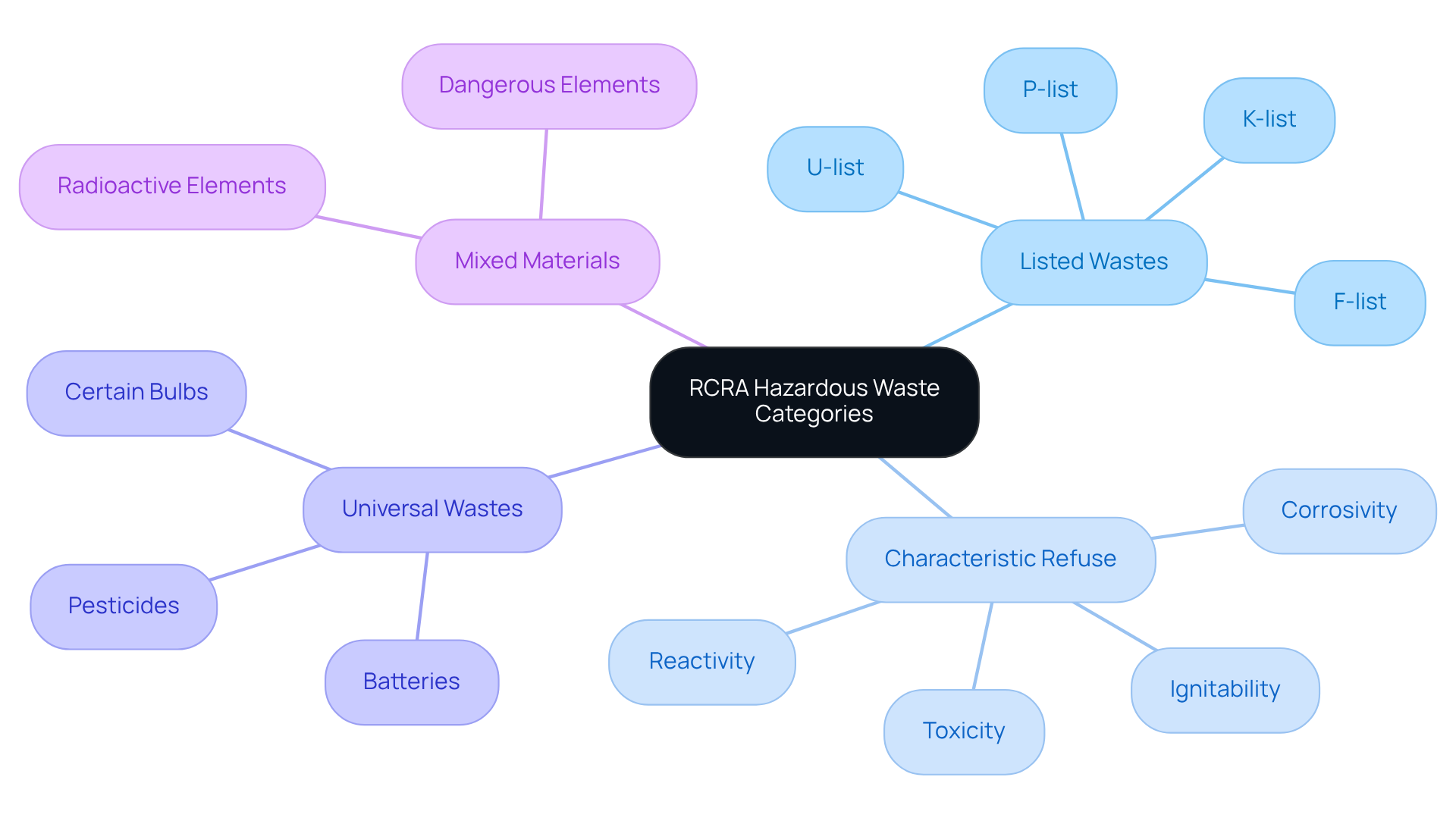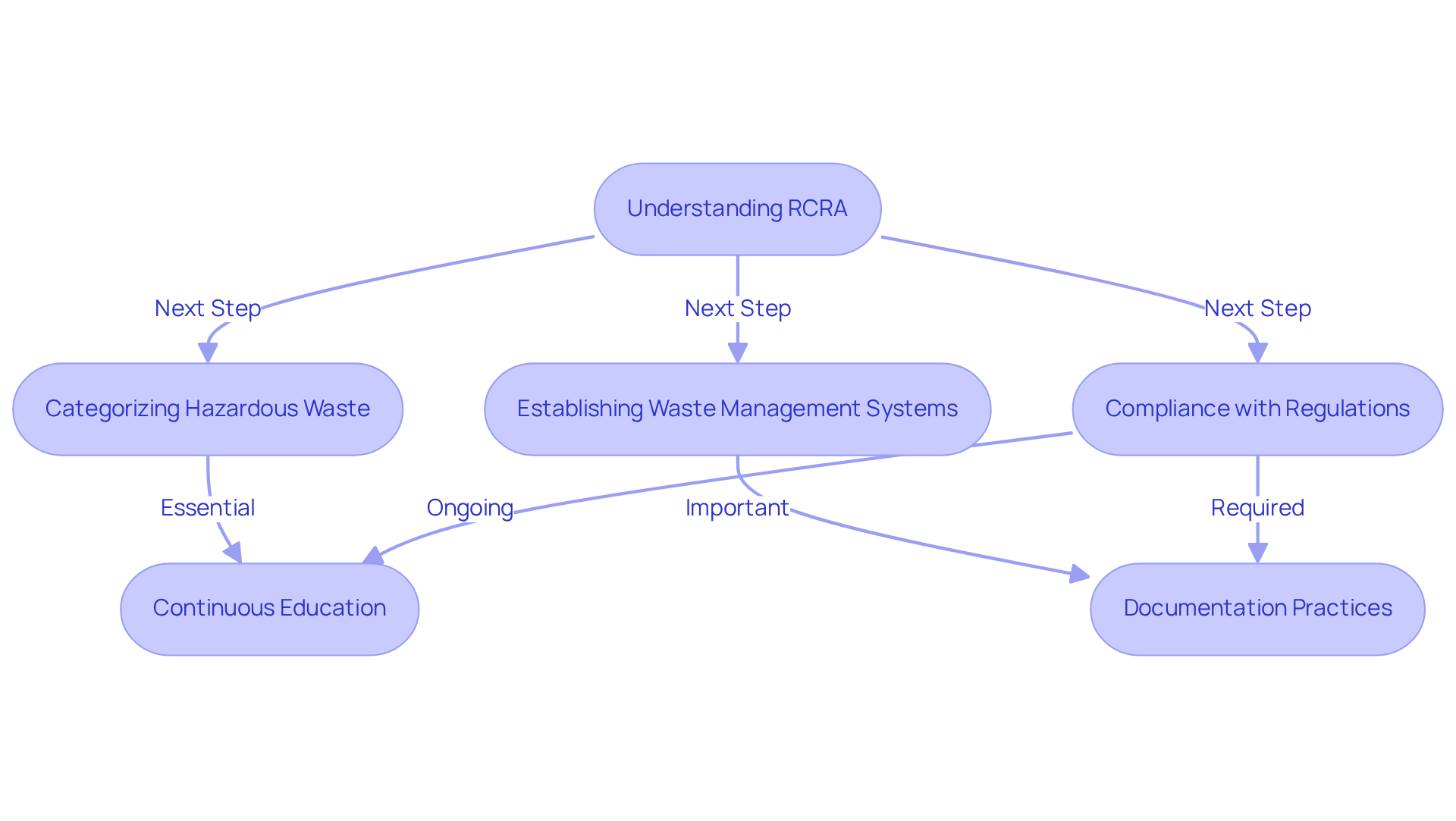What is RCRA? Understanding Its Purpose and Impact on Compliance

Overview
The Resource Conservation and Recovery Act (RCRA) stands as a pivotal federal law designed to manage both hazardous and non-hazardous waste. Its primary objective is to safeguard human health and the environment through a comprehensive 'cradle-to-grave' framework. This article underscores RCRA's critical importance in ensuring compliance within the life sciences sector. It emphasizes the act's regulatory role over hazardous materials and its promotion of sustainable practices, which are essential for minimizing environmental risks and enhancing organizational responsibility.
Addressing compliance challenges is paramount for organizations operating within this sector. RCRA not only delineates the responsibilities associated with hazardous waste management but also encourages the adoption of best practices that align with sustainability goals. By integrating these practices, organizations can significantly reduce their environmental footprint while bolstering their commitment to regulatory compliance.
In conclusion, engaging with the principles of RCRA is not merely a legal obligation; it is a strategic advantage that fosters a culture of responsibility and sustainability. Organizations are urged to leverage compliance solutions that align with RCRA, ensuring they meet regulatory standards while enhancing their operational integrity.
Introduction
The Resource Conservation and Recovery Act (RCRA) serves as a crucial framework in the United States for the management of both hazardous and non-hazardous waste, safeguarding human health and the environment. As organizations confront the complexities inherent in waste management, grasping RCRA's comprehensive guidelines is vital for ensuring compliance and fostering sustainable practices.
With the landscape of regulations continually evolving and new pollutants emerging, businesses must consider: how can they effectively navigate these challenges while adhering to stringent standards?
This article explores the significance of RCRA, its influence on the life sciences sector, and the essential role it plays in promoting responsible waste management practices.
Define RCRA and Its Purpose
The Resource Conservation and Recovery Act (RCRA), established in 1976, is a cornerstone federal law that defines what is RCRA in relation to the management of both hazardous and non-hazardous solid materials in the United States. Its primary goal is to protect human health and the environment by ensuring the safe disposal of waste.
What is RCRA? It provides a comprehensive framework for hazardous materials oversight, encompassing the entire lifecycle from generation to disposal—a concept commonly referred to as 'cradle-to-grave' oversight. This framework includes rigorous , transportation, treatment, storage, and disposal, all designed to minimize environmental impacts while promoting resource conservation.
As we approach 2025, it is important to understand what is RCRA, as it continues to adapt with updates that reflect the growing complexities of hazardous waste management. The EPA currently oversees approximately 6,600 facilities managing over 20,000 process units to ensure compliance with what is RCRA regulations. The act also addresses the urgent need for improved oversight practices, particularly in light of emerging pollutants such as PFAS, which have escalated cleanup requirements. In 2021, large quantity generators produced 35.9 million tons of hazardous waste, yet only 1.6 million tons were recovered or recycled, underscoring the challenges within the recycling infrastructure.
What is RCRA, and how does its framework facilitate efficient waste management while playing a crucial role in the effective implementation of regulatory programs across the life sciences sector? By adhering to RCRA guidelines, organizations can effectively navigate the complexities of hazardous material management, which raises the question: what is RCRA, and how does it ensure compliance with Good Manufacturing Practices (GMP), ISO standards, and Quality System Regulations (QSR)? This commitment to regulatory compliance is vital for upholding high standards of safety and environmental protection within the industry.

Identify RCRA Hazardous Waste Categories
The Resource Conservation and Recovery Act (RCRA) categorizes dangerous materials into several distinct groups to streamline management and ensure adherence. Understanding and these categories is essential for organizations aiming to comply with regulations and implement effective disposal strategies. The primary categories include:
-
Listed Wastes: Specific wastes identified by the EPA, divided into four lists:
- F-list: Wastes from common industrial processes.
- K-list: Wastes from specific industries.
- P-list: Discarded commercial chemical products.
- U-list: Wastes that are toxic.
-
Characteristic Refuse: Materials exhibiting dangerous qualities, including ignitability, corrosivity, reactivity, and toxicity.
-
Universal Wastes: Commonly generated dangerous materials, such as batteries, pesticides, and certain types of bulbs, which are subject to less stringent regulations to promote recycling and proper disposal.
-
Mixed Materials: Combinations of radioactive and dangerous elements, necessitating specialized management and disposal techniques.
Recent updates from the EPA underscore the importance of appropriate categorization and oversight of these materials, particularly in the life sciences sector, where compliance with toxic substance regulations is critical for operational integrity and environmental protection. Notably, approximately 5% to 10% of pharmaceutical products qualify as RCRA hazardous materials, highlighting the urgent need for meticulous disposal practices. AVS Life Sciences offers specialized consulting services to assist organizations in understanding what is RCRA regulations, ensuring adherence to EPA guidelines for proper disposal. Case studies in pharmaceutical refuse handling further illustrate the necessity of these classifications and the pivotal role of AVS Life Sciences in helping clients achieve compliance and effective waste management.

Explore RCRA's Impact on Life Sciences Compliance
What is RCRA, and how it plays a pivotal role in ensuring conformity within the life sciences sector, where effective handling of hazardous materials is essential for regulatory adherence and public safety? Organizations must navigate intricate regulations to align their disposal practices with RCRA requirements, and knowing what is RCRA is essential, as non-compliance can lead to significant penalties, including fines that can reach up to $37,500 per day for each violation.
For pharmaceutical firms, knowing what is RCRA is particularly critical due to the hazardous nature of their waste, which often contains outdated medications and chemical byproducts. Establishing robust waste management systems that accurately categorize and manage hazardous waste is imperative. Case studies, such as AVS Life Sciences' recent collaboration with a prominent biotechnology firm, illustrate that large quantity generators (LQGs) frequently encounter challenges with regulations, particularly regarding written contingency plans, which can result in missing elements and outdated procedures. In this instance, AVS Life Sciences provided comprehensive consulting services, including GMP audits and regulatory compliance solutions, to enhance the client's manufacturing area to a Level 2 GMP facility, ensuring that quality assurance measures were established to support conformity with regulatory standards. Continuous education and vigilance in labeling and documentation practices are vital to mitigate these risks.
Moreover, what is RCRA compliance fosters a culture of environmental responsibility, encouraging organizations to adopt sustainable practices that limit resource consumption and enhance recycling initiatives. By understanding what is RCRA and adhering to its regulations, life sciences firms not only minimize risks associated with hazardous materials but also bolster their reputation as responsible corporate citizens dedicated to protecting human health and the environment. This commitment is reflected in the among RCRA-regulated facilities, with the EPA reporting over 90% compliance, showcasing what is RCRA and its positive impact on hazardous waste management practices, along with the role of AVS Life Sciences in achieving these outcomes.

Conclusion
The Resource Conservation and Recovery Act (RCRA) stands as a pivotal framework for the management of both hazardous and non-hazardous waste in the United States, underscoring the necessity of safe disposal practices to safeguard human health and the environment. By instituting comprehensive regulations that oversee the entire lifecycle of waste, RCRA is instrumental in ensuring compliance across various industries, particularly within the life sciences sector, where the management of hazardous materials is critical.
Key points throughout the article highlight:
- The categorization of hazardous waste
- The imperative of compliance to avert severe penalties
- The role of organizations such as AVS Life Sciences in delivering essential consulting services
The challenges encountered by large quantity generators in adhering to RCRA regulations accentuate the need for ongoing education and robust waste management systems. Furthermore, the positive influence of RCRA compliance on environmental responsibility and corporate reputation illustrates the act's effectiveness in fostering sustainable practices.
Ultimately, grasping the implications of RCRA for waste management is essential for organizations aiming to meet regulatory standards and cultivate a culture of environmental stewardship. As the landscape of hazardous waste management evolves, remaining informed and proactive in compliance efforts will not only mitigate risks but also contribute to a healthier planet. Embracing the principles of RCRA transcends mere legal obligation; it embodies a commitment to responsible environmental practices that yield benefits for society at large.
Frequently Asked Questions
What is RCRA?
The Resource Conservation and Recovery Act (RCRA) is a federal law established in 1976 that defines the management of hazardous and non-hazardous solid materials in the United States, aiming to protect human health and the environment through safe waste disposal.
What is the primary goal of RCRA?
The primary goal of RCRA is to ensure the safe disposal of waste, thereby protecting human health and the environment.
What does the 'cradle-to-grave' concept refer to in RCRA?
The 'cradle-to-grave' concept in RCRA refers to the comprehensive framework for hazardous materials oversight that encompasses the entire lifecycle of waste, from generation to disposal.
How does RCRA regulate waste management?
RCRA includes rigorous regulations governing waste generation, transportation, treatment, storage, and disposal, all designed to minimize environmental impacts and promote resource conservation.
What role does the EPA play in relation to RCRA?
The EPA oversees approximately 6,600 facilities managing over 20,000 process units to ensure compliance with RCRA regulations.
What challenges does RCRA face regarding hazardous waste management?
RCRA faces challenges such as the increasing complexity of hazardous waste management and the need for improved oversight practices, particularly concerning emerging pollutants like PFAS.
How much hazardous waste was produced in 2021, and what percentage was recovered or recycled?
In 2021, large quantity generators produced 35.9 million tons of hazardous waste, but only 1.6 million tons were recovered or recycled, highlighting challenges within the recycling infrastructure.
How does RCRA support compliance with industry standards?
By adhering to RCRA guidelines, organizations can navigate the complexities of hazardous material management and ensure compliance with Good Manufacturing Practices (GMP), ISO standards, and Quality System Regulations (QSR), which are vital for maintaining safety and environmental protection standards.
